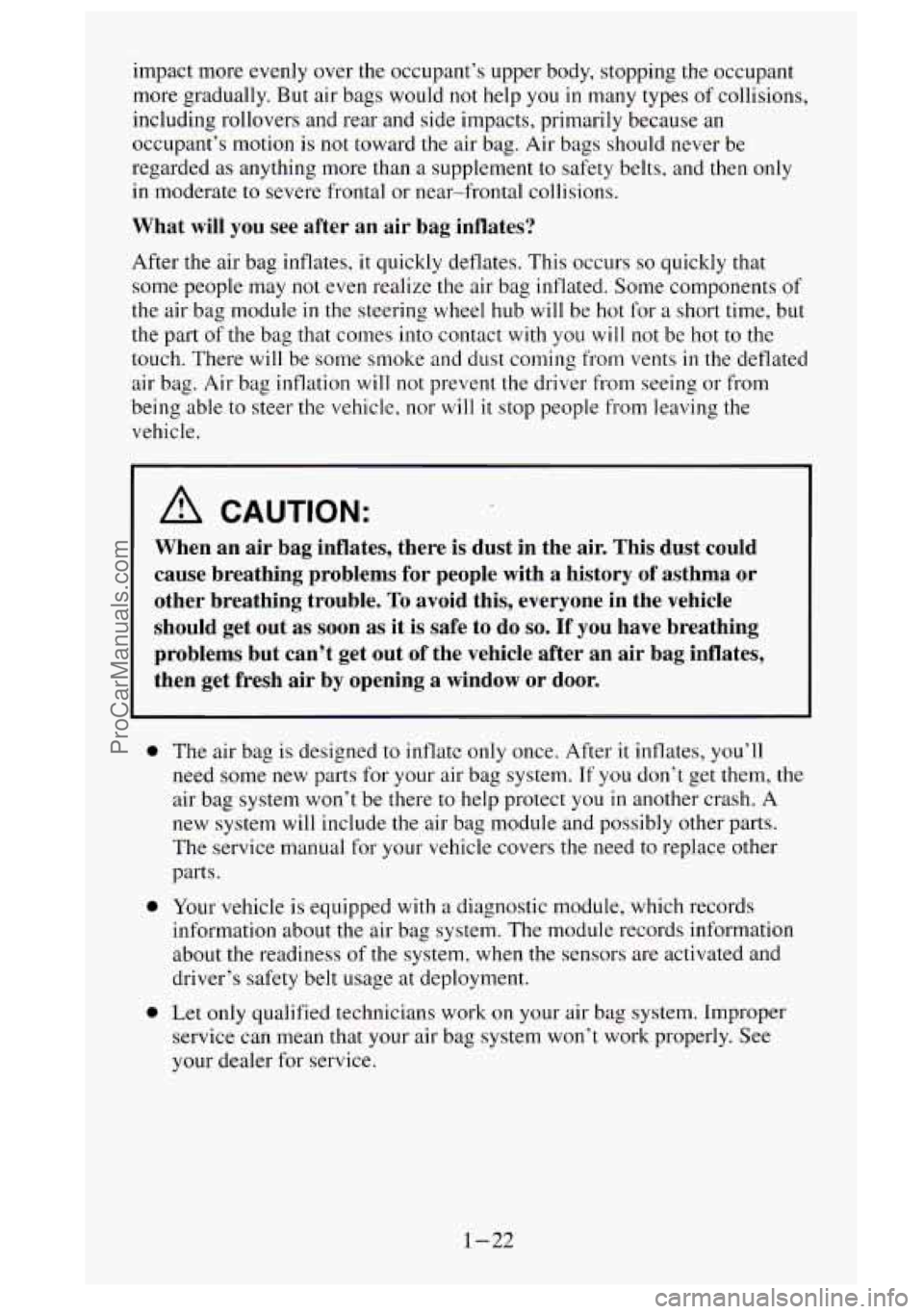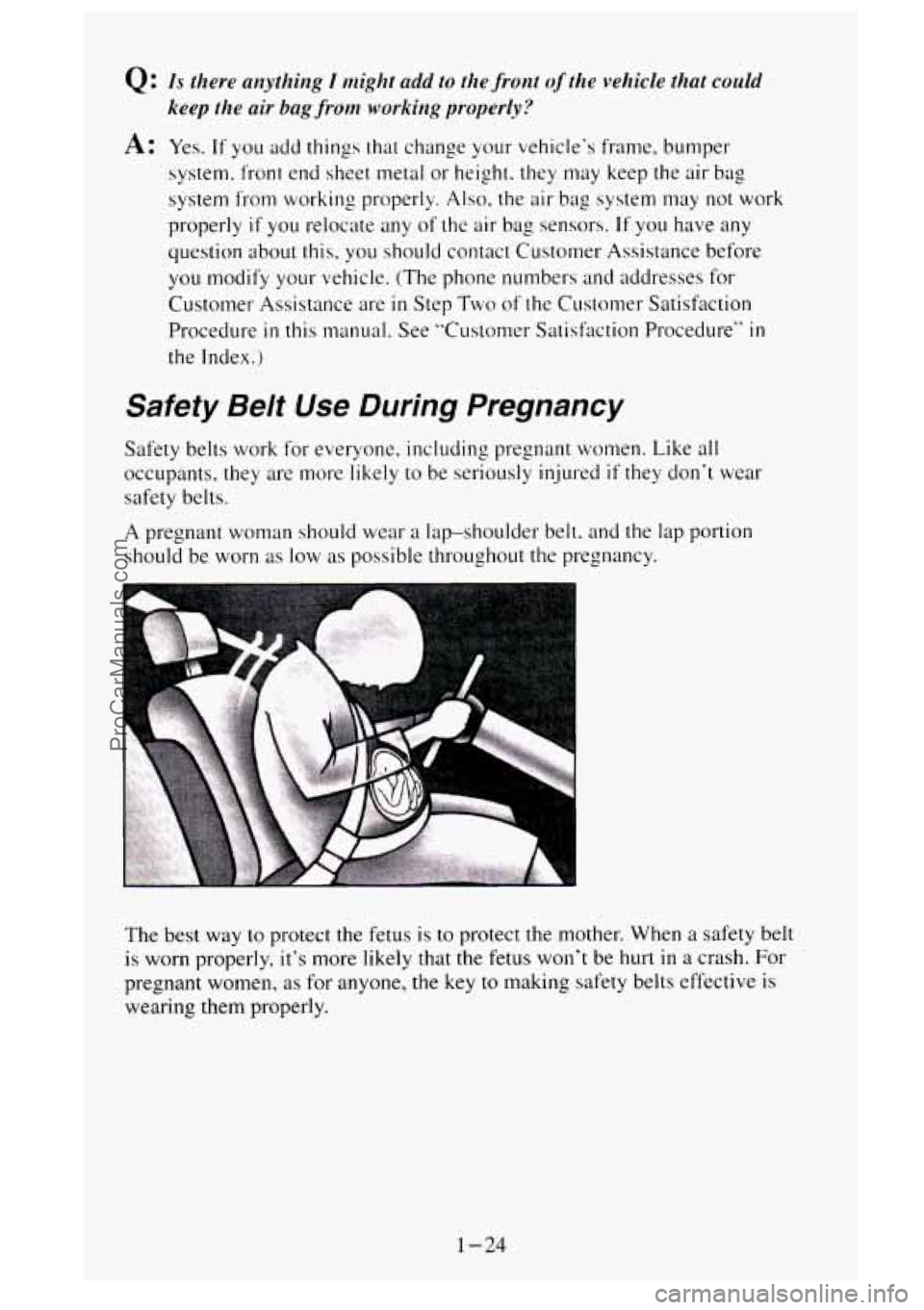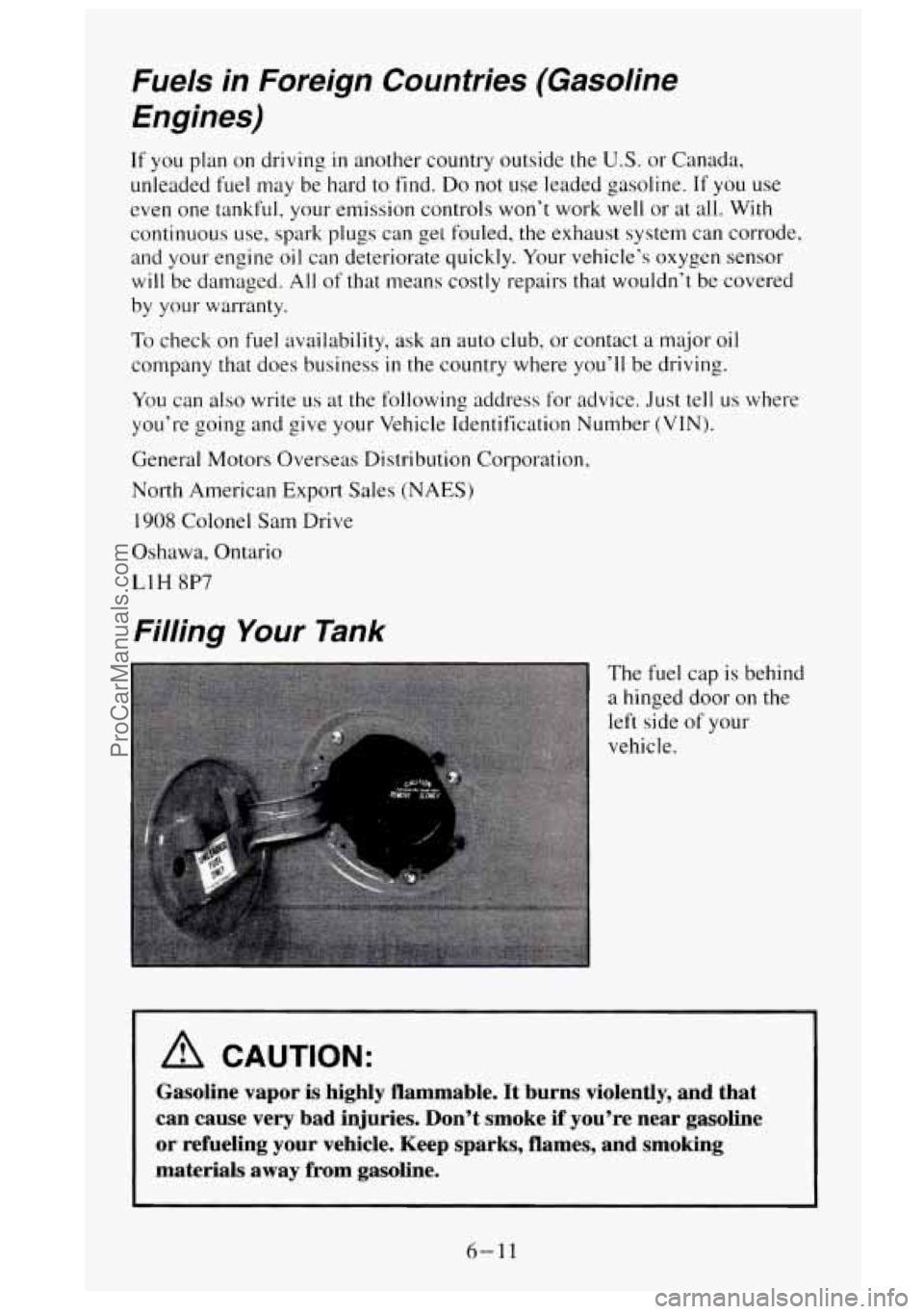1995 GMC SIERRA sensor
[x] Cancel search: sensorPage 38 of 488

impact more evenly over the occ.upant’s upper body, stopping the occupant
more gradually. But air bags would not help you
in many types of collisions,
including rollovers and rear and side impacts, primarily because an
occupant’s motion
is not toward the air bag. Air bags should never be
regarded
as anything more than a supplement to safety belts, and then only
in moderate to severe frontal or near-frontal collisions.
What will you see after an air bag inflates?
After the air bag inflates, it quickly deflates. This occurs so quickly that
some people may not even realize the air bag inflated. Some components of
the air bag module
in the steering wheel hub will be hot for a short time, but
the part of the bag that comes into contact with you will not be hot to the
touch. There will be some smoke
and dust coming from vents in the deflated
air bag. Air bag inflation
will not prevent the driver from seeing or from
being able to steer the vehicle, nor
will it stop people from leaving the
vehicle.
A CAUTION:
When an air bag inflates, there is dust in the air. This dust could
cause breathing problems for people with
a history of asthma or
other breathing trouble. To avoid this, everyone in the vehicle
should get out as soon as it
is safe to do so. If you have breathing
problems but can’t get out of the vehicle after an air bag\
inflates,
then get fresh air
by opening a window or door.
e
e
0
The air bag is designed to inflate only once. After it inflates, you’ll
need some new parts for your air bag system.
If you don’t get them, the
air
bag system won’t be there to help protect you in another crash. A
new system
will include the air bag module and possibly other parts.
The service manual for your vehicle covers the need to replace other
parts.
Your vehicle is equipped with a diagnostic module, which records
information about the air bag system. The module records information
about the readiness of the system, when
the sensors are activated and
driver’s safety belt usage at deployment.
Let only qualified technicians work on your air bag system. Improper
service can mean that your air bag system won’t work properly. See
your dealer for service.
1-22
ProCarManuals.com
Page 40 of 488

Q: Is there anything I might add to the front of the vehicle that could
keep the air bag from working properly?
A: Yes. If you add things that change your vehicle's frame, bumper
system. front end sheet metal or height. they may keep the air
bag
system f'rom working properly. Also. the air bag system may not work
properly
if you relocate any of the air bag sensors. If you have any
question about this, you should contact Customer Assistance before
you modify your vehicle. (The phone numbers and addresses for
Customer Assistance are
in Step Two of the Customer Satisfaction
Procedure
in this manual. See "Customer Satistiaction Procedure" in
the Index.)
Safety Belt Use During Pregnancy
Safety belts work for everyone, including pregnant women. Like all
occupants. they are more likely to be seriously injured if they don't wear
safety belts.
A pregnant woman should wear a lap-shoulder belt. and the lap portion
should be worn
as low as possible throughout the pregnancy.
The best way
to protect the fetus is to protect the mother. When a safety belt
is worn properly, it's more likely that the fetus won't be hurt
in a crash. For
pregnant women, as for anyone, the key
to making safety belts effective is
wearing them properly.
1-24
ProCarManuals.com
Page 133 of 488

Safety Belt Reminder Light
When the key is turned to RUN or START, a tone will come on for about
eight seconds to remind people to fasten their safety belts, u\
nless the
driver’s safety belt is already buckled. The safety belt light will also come
on and stay on for about 20 seconds, then it will flash for about 55 seconds.
If the driver’s belt is already buckled, neither the tone nor \
the light will
come on.
Air Bag Readiness Light
There is an air bag readiness light on the instrument panel, which shows
AIR BAG. The system checks the air bag’s electrical system for
malfunctions. The light tells you if there is an electrical problem. The
system check includes the air bag sensors and module, the wiri\
ng and the
diagnostic module.
For more information on the air bag system, see “Air
Bag” in the Index.
2-71
ProCarManuals.com
Page 277 of 488

Fuels in Foreign Countries (Gasoline Engines)
If you plan on driving in another country outside the U.S. or Canada,
unleaded fuel may be hard to find.
Do not use leaded gasoline. If you use
even one tankful, your emission controls won’t work well or at all. With
continuous use, spark plugs can get fouled, the exhaust system can corrode,
and your engine
oil can deteriorate quickly. Your vehicle’s oxygen sensor
will be damaged.
All of that means costly repairs that wouldn’t be covered
by your warranty.
To check on fuel availability, ask an auto club, or contact a major oil
company that does business in the country where you’ll be driving.
You can also write
us at the following address for advice. Just tell us where
you’re going and give your Vehicle Identification Number
(VIN).
General Motors Overseas Distribution Corporation,
North American Export Sales (NAES)
1908 Colonel Sam Drive
Oshawa, Ontario
LlH 8P7
Filling Your Tank
The fuel cap is behind
a hinged door on
the
left side of your
vehicle.
A CAUTION:
Gasoline vapor is highly flammable. It burns violently, and that
can cause very bad injuries. Don’t smoke
if you’re near gasoline
or refueling your vehicle. Keep sparks, flames, and smoking
materials away from gasoline.
6-11
ProCarManuals.com
Page 323 of 488

Three- Way Catalytic Converter (Gasoline Engines)
Your vehicle’s three-way catalytic converter is designed to reduce the
pollutants
in your vehicle‘s exhaust. Use only unleaded fuel in your vehicle.
If you use leaded fuel, you could damage your three-way catalytic converter
and other engine components.
Oxidation Catalytic Converter (Diesel Engines)
Your vehicle’s oxidation catalytic converter is designed to reduce the
particulates
in your vehicle‘s exhaust. If your vehicle’s oxidation catalytic
converter ever needs to be replaced,
it must be replaced with an oxidation
converter intended for use
with diesel engines only.
Engine Control Module System
Gasoline Engines
This system has an oxygen sensor (OS) that helps keep your engine’s
air-fuel mixture at a proper level. Use only unleaded fuel in your vehicle. If
you use leaded fuel, you could damage your oxygen sensor
(OS) and
three-way catalytic converter.
Diesel Vehicles Below 8,500 (3 850 Kg) G VWR
This system monitors engine speed and throttle position. It adjusts exhaust
gas recirculation to limit emissions.
Malfunction Indicator (SERVICE ENGINE SOON)
Light
The Malfunction Indicator (SERVICE ENGINE SOON) Light on your
instrument panel lets you know when your emission system needs service.
The light will come on briefly when you start your engine to
let you know
that the system is working. If
it does not come on when you start your
engine, or
if it comes on and stays on while you’re driving, your system
may need service. Your vehicle should still be driveable, but you should
have your system serviced right away.
Secondary Air Injection Reaction (AIR) System
(Gasoline Engines)
You may have this system. It has a control valve that will direct air to where
it is needed. If the AIR system needs service, your Malfunction Indicator
(SERVICE ENGINE
SOON) Lamp on your instrument panel will come on.
6-57
ProCarManuals.com